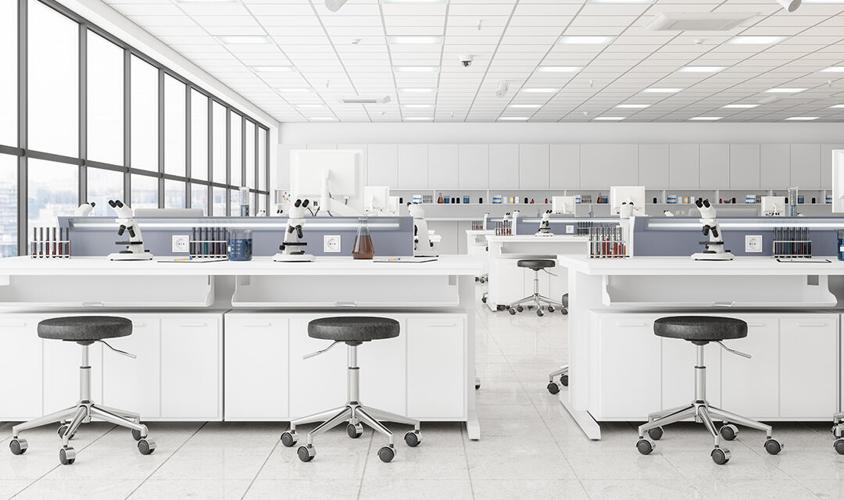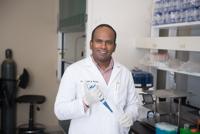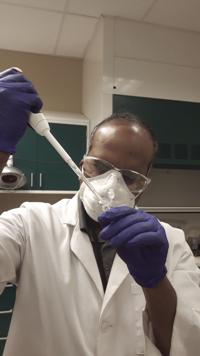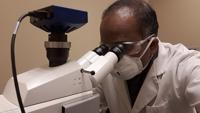How Drs. Joseph and Renuka Roche pinpointed a potential treatment for Covid-19
By Eric Adelson
At first, Joseph and Renuka (“Ray”) Roche just followed the news about the coronavirus, like everyone else.
After all, they’re not epidemiologists. He is a physical therapist. She is an occupational therapist. So to the Roches, back in January, the novel coronavirus landed somewhere between curiosity and concern. It was dinner table talk, mixed in with chatter about how their 6-year-old daughter, Vanya, did at school.
At first.
“We did not think it would become a pandemic,” says Joseph. “We were talking about the disease, that’s all.” Then Covid-19 found its way to American shores. The Jain Foundation, based in Seattle near the first domestic outbreak, funded a lot of the Roches’ work on muscular dystrophy. Curiosity gave ground to concern. Then, over the cold weeks of February and March, the threat spread. “Now,” Joseph told his wife, “this is our problem.”
Nearly a year later, the Roches, who live in Canton, are still a little bit surprised how much of their problem this really is. Because while the nation hinges its hopes on the vaccine news out of companies like Pfizer and Moderna, the Roches came up with a distinctly different approach to the battle against Covid-19. They’ve isolated a potential explanation for the array of symptoms associated with the disease. And they’ve pinpointed an existing drug that could help mitigate these symptoms — but that hardly anyone is talking about.

Dr. Joseph Roche is an associate professor of physical therapy at Wayne State University.
The Roches’ titles are as long as their road to Michigan. Joseph is the Eugene Applebaum College of Pharmacy and Health Sciences Associate Professor of Physical Therapy at Wayne State University. Ray is an assistant professor of occupational therapy (with a focus on developmental neurology) at Eastern Michigan University. They are both from India, where they met. Ray came to the University of Illinois at Chicago for her master’s degree in occupational therapy, while Joseph joined the Ph.D. program in physical therapy and rehabilitation science at the University of Maryland School of Medicine in Baltimore. They moved to Southeast Michigan in 2014.
Their paths wind to the same place every night: the dinner table, talking about how the body works. “We have brainstorms that go on eternally,” says Joseph. “Our daughter has to fight for attention.”

Dr. Renuka (“Ray”) Roche is an assistant professor of occupational therapy at Eastern Michigan University.
Last year, unsurprisingly, a lot of the attention went to Covid-19 and the respiratory issues it triggers. “My own mother had a dry hacking cough because of an ACE inhibitor,” says Joseph, referring to a treatment for hypertension. (ACE is an enzyme that regulates blood pressure.) “It would keep her awake at night.” Hearing reports that people with Covid-19 were also battling dry coughs, “We thought there might be a link in terms of how [Covid-19-related] coughs were being developed with the same mechanism,” says Ray.
Once the virus enters the body, it can lead to a spike in bradykinin, which causes a whole host of problems, from leaky blood vessels to fluid in the lungs.
In late March, the Roches came up with a theory. And buckle up, because here’s where it gets science-y. The theory homes in on a chemical produced by the body called bradykinin, a peptide (a chain of amino acids) that “plays a role in the mediation of cough reflex, pain signals and blood pressure,” says Joseph, adding that it’s “grossly overlooked…people don’t talk about bradykinin that much.”
Long story short, once the virus that causes Covid-19 enters the body, it can lead to a spike in bradykinin, says Joseph, which ultimately causes inflammatory signals to increase. Blood vessels, no longer regulated, can leak. And then there’s a whole host of problems that wouldn’t seem to logically follow from something that enters the body through the mouth and nose. “If [oxygen] gets low enough,” says Dr. Allen Kaplan of the Medical University of South Carolina, one of the nation’s experts on bradykinin, “it starts to affect other organ systems.”

Joseph and Ray (not pictured) are working with researchers worldwide to test their hypothesis around a treatment for Covid-19.
The Roches’ eureka moment came one night in March after watching a local news feature about ACE2 and ACE inhibitor drugs — specifically how ACE2 (a protein on the surface of some cells) was the point of entry for the virus; it allows the virus that causes Covid-19 to attach onto and invade our cells. (That spike you’ve seen on coronavirus graphics on the news? That’s what binds with the ACE2 receptor that leads to infection.)
The report raised questions on possible links between Covid-19 symptoms and the medications that patients were potentially taking. Suddenly, a virus that confounded millions started to make a lot more sense to the Roches. They stayed up past 3 a.m. composing an email to the TV station, suggesting a drug called icatibant — which had already been approved by the FDA for a skin condition called angioedema — that could block bradykinin receptors, thereby easing respiratory distress.
A few days later, the Roches published an open letter with their proposal. Wait a minute, you may ask. After all these months of waiting and debate over vaccines and therapeutics and hydroxychloroquine and remdesivir, there’s an FDA-approved drug called icatibant that can potentially help treat this plague — and it isn’t currently part of the standard of care?
And the answer is … well, maybe.

Dr. Renuka (“Ray”) Roche
Soon after the open letter, the Roches got a paper fast-tracked into a medical journal — not easy during a flood of research on a worldwide crisis. Their idea gained traction. Research from credible sources has backed them up, including a July report from the renowned Oak Ridge National Laboratory that stated “bradykinin-driven outcomes explain many of the symptoms being observed in Covid-19.” A small study from the Netherlands that was published in the journal JAMA Network Open in August found that icatibant helped improve oxygenation in patients with Covid-19.
So, what’s the holdup on icatibant being used as part of treatment? Covid-19 cases are spiking out of control. Hospitalizations have soared. As of press time, daily U.S. deaths number 3,000-plus. This American tragedy is ruining the lives of even those who don’t get the disease. “Clinical practice depends on clinical trials,” says Joseph.
They’re aware there’s some disbelief that at least part of the answer to treating this virus is right there in front of the world.
To this point there has been little in the way of clinical trials on icatibant’s possible use as related to the disease. “Even if a bunch of us think it may be contributing,” says Kaplan of the drug, “we’re not there yet.” (He has never met or spoken with the Roches.)

Dr. Joseph Roche
And we’re not there yet in terms of a vaccine, either — despite Pfizer rolling out its vaccine in December and, as of press time, Moderna’s vaccine expected to be authorized shortly. “We are cautiously optimistic,” says Joseph of the Pfizer vaccine. “Optimistic, because safe and effective vaccines could help exit the pandemic soon.” But cautious because the vaccines after the 2003 SARS-CoV outbreak weren’t seamless when introduced.
Perhaps at some point icatibant could be included in a compassionate care regimen for advanced cases. That would be a big next step. Wayne State and Eastern Michigan are both fully supportive of the Roches’ efforts. The research — and push for awareness — are part of what the couple does every week now. “We are working with collaborators worldwide to collect data to test the hypothesis that dysregulated [brady]kinin signaling is involved in Covid-19,” says Joseph.
In the meantime, he remains at the dining room table every night, dishing with Ray and explaining it all to Vanya. The Roches are aware there’s some skepticism and disbelief that at least part of the answer to treating the effects of this destructive virus is already right there in front of the world. People just have to get over the hurdle of “What would a physical therapist and an occupational therapist know about Covid-19?”
Turns out, quite a bit.

Dr. Joseph Roche
Cracking the Code
For those of us not in the science or medical field, understanding how Covid-19 wreaks havoc on the body — and what can be done to ease its effects — is no simple feat. Here are some key terms to know.
ACE2: A protein on the surface of some human cells that also serves as the entry point for the coronavirus that causes Covid-19.
After spiky proteins on virus particles bind with the ACE2 receptor on a given cell, they take over the cell and multiply, causing infection — and an increase in bradykinin levels.
Bradykinin: A peptide (chain of amino acids) that plays a role in functions like cough reflex, pain signals and blood pressure.
Once Covid-19 infects respiratory cells and elevates bradykinin levels, inflammation and irritation can result.
While Covid-19 is mainly a respiratory disease, any host cell that has ACE2 on its surface is capable of getting infected and triggering an increase in bradykinin levels. This can spell trouble for everything from blood vessels (they can leak) to the lungs (which can fill up with fluid).
Icatibant: A drug that blocks bradykinin receptors and eases breathing difficulty in Covid-19 patients.
The drug is FDA approved for a skin condition called angioedema, but the Roches suggest — and a small study from the Netherlands has shown — that it can help improve oxygenation in patients battling Covid-19.



















(0) comments
Welcome to the discussion.
Log In
Keep it Clean. Please avoid obscene, vulgar, lewd, racist or sexually-oriented language.
PLEASE TURN OFF YOUR CAPS LOCK.
Don't Threaten. Threats of harming another person will not be tolerated.
Be Truthful. Don't knowingly lie about anyone or anything.
Be Nice. No racism, sexism or any sort of -ism that is degrading to another person.
Be Proactive. Use the 'Report' link on each comment to let us know of abusive posts.
Share with Us. We'd love to hear eyewitness accounts, the history behind an article.